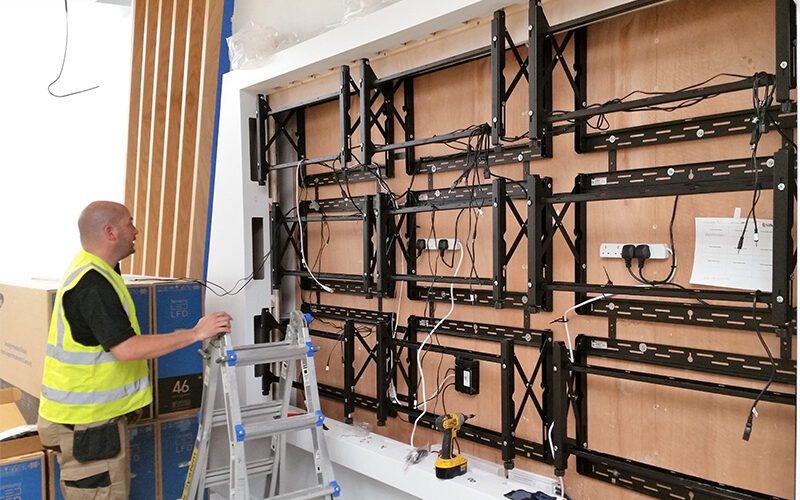11 Benefits Of Using Digital Signage For Corporate Communication
Digital signage can be a highly effective tool for corporate communication.
We outline 11 key benefits of using it, highlight some popular applications, and outline how to build a robust business case for investing in it.
1. Increases capacity for communication (without cluttering inboxes)
Due to the sheer volume of information that flows around a business, staff can feel overloaded if lots of internal communications messages are added to their already over-flowing email inboxes.
Digital signage can quickly deliver lots of information in a very convenient way. Staff view it when they want to and for as long as they like– usually when taking a break from one activity before starting another – e.g. on a coffee break.
2. Highlights key messages
Most large businesses have a system for corporate communication (e.g. an intranet), but these are often clunky and information-heavy, making them uninviting for staff to use regularly.
Digital signage is very eye-catching and therefore hard to ignore. It can highlight important messages in a succinct and interesting way, which encourages staff to take an interest in the subject and refer to other internal information sources (e.g. the company intranet) to find out more.
3. Make messages more memorable
Psychologists have proved that humans are ten times more likely to remember a narrative/story than a single stand-alone piece of information. Digital signage makes it easy to convey information as a narrative.
Internal communications professionals simply need to create a video (related to their communication goals) that takes employees through a narrative process. Staff will be significantly more likely to remember the content than if it were presented as stand-alone facts.
4. Message reinforcement
Psychologists believe that the more times a person sees and pays attention to a message, the more memorable it will be. However, there is a big difference between seeing something and paying attention to it.
When a message is static (e.g. a printed sign) people may read and pay attention to it the first time they see it. However, they’re likely to ignore it afterwards because their brain has subliminally categorised it as not being immediately important. They will see it but not pay attention it.
Because humans are visually attracted to movement they are much more likely to pay attention to moving pictures on a screen, and to take notice of any messages on it.
Digital signage is visible all day long and can be used to show the same messages on a frequent basis which continuously reinforces them, making them more memorable.
If screens are showing messages regarding operational best practice or safety warnings, staff will be much more likely to remember the guidance and follow the desired behaviours.
5. Variable message visibility
Some messages are more important and/or time sensitive than others. With digital signage, message visibility can be dialled up or down, depending on how important and/or time-sensitive it is. You can do this simply through scheduling content to appear more or less frequently. Subsequently, the likelihood of staff not just seeing the relevant message, but remembering and acting upon it too, can be controlled by the business.
6. Consistency across locations/situations
Staff that work outside of a business’s head office can often feel undervalued/resentful if they hear about key information later than HQ staff. Digital signage enables businesses to give all staff the same information at the same time, in exactly the same format, making important announcements simpler to schedule and deliver.
Similarly, workers’ laptops can be added into a digital signage estate, enabling remote workers see the same internal messages as office-based staff, via the screensaver function.
7. Instant updates
Working towards a target when you can’t see the impact your own personal efforts are having is demotivating. This can lead to staff becoming dissatisfied and looking for a job elsewhere, resulting in high turnover of staff and higher recruitment costs. Digital signage can be used to keep staff in the loop and feel more involved in the success of the business.

Content management systems like SaturnVision can be integrated with third party IT systems, so that the information on screens can be updated instantly through automation. This gives staff up-to-the minute performance information about how close they are to achieving their team’s target and what needs to be done to succeed, as it happens. This empowers staff to engage with the target and see how much they as a team or an individual can ‘move the needle’.
8. Reinforces company mission/shapes company culture
A business’s mission and values should drive how decisions are made and shape behaviours, but they can be difficult to reinforce.
Digital signage can be used to display written values and to share stories about individuals applying the values in their role, outlining what the subsequent positive results were for both the individual and the business.
When values are constantly visible and easy to understand, they are more likely to influence the behaviour of staff across the organisation. This doesn’t just mean encouraging positive behaviours, but also discouraging negative behaviour. When staff are able to recognise if their colleagues demonstrate behaviour and decisions which doesn’t align with the messages/values being reinforced, they are more likely to call it out when they see it.
9. Engage staff more effectively
Most internal communications channels tend to be fairly inflexible (e.g. intranet, emails, posters, newsletters), making it hard to deliver exciting and impactful content and get buy-in from staff.
With the right software, digital signage can be used to play live action or animated videos, display still images, graphs, charts, newsfeeds, social media or even show presentations that have been turned into videos.
This flexibility enables organisations to be more innovative with their corporate communications campaigns, and to come up with ideas that will ‘wow’ their staff. They also make it easier to convey and embed a brand personality more effectively.
Innovative message delivery also communicates to staff that they are working for a progressive, employee-focussed organisation. This can reinforce any company values that relate to innovation or progressiveness and can change staff perception of the company they work for, increasing staff retention.
10. Engage visitors

Within a digital signage estate, different screens can show different content at different times. Subsequently, organisations can create their own channel/content for their reception areas. Visitors can be shown tailored information (e.g. CSR initiatives, share prices, latest research highlights, work examples, careers information) whilst waiting for meetings, job interviews etc. This creates opportunities to impress new business prospects, partners or potential employees.
11. Increase trust
According to recent research, 30% of internal communications professionals said that employee trust of senior management was an issue. It’s not unreasonable for a business’s employees to question what happens around the board table, especially if the company is experiencing difficult times.
The more staff know about the ‘goings on’ in a company, the more likely they are to understand the complexity that the business’s leaders face, and support their decisions and trust them. Digital signage makes it easy for companies to be open and keep staff abreast of ongoing developments, making them feel informed and engaged.
Building a business case for using digital signage for corporate communications
As you can see, the flexibility of digital signage makes it a very useful tool not just for HR, but also for rectifying issues related to H&S, operations, training and branding – and it can tackle a single issue or multiple problems at once.
Whilst digital signage is a clear ‘no-brainer’ for internal communications in a large organisation, it can involve a sizeable initial investment which doesn’t immediately have a clear tangible return on investment.
However, what it does have is a great track record for success with corporate communication. When it’s used in the right location with the right content for the right reasons, it can quickly pay for itself.
First of all, identify the key problems you’d like to use digital signage to tackle, then try to calculate a figure for what that costs your organisation each year.
Speak to a good digital signage consultancy about those problems and any others (even those that don’t obviously seem related to communication) and they should be able to help you identify if and how digital signage could help reduce or solve them.
They should then be able to help you identify what an appropriate solution would be and how much it would cost (and if necessary, make suggestions as to how to spread or reduce it).
Once you have that figure, you can then identify the cost to your business of all of the problems that could be alleviated by using digital signage over five years and calculate how long it will take to pay for itself. It’s surprising how easy it is to build a business case that not only stacks up, but makes great business sense.
You can download a PDF containing a summary of the points above here –11 benefits of using digital signage for corporate communication download
If you’d like to learn more about building a business case for digital signage, why not check out this article we’ve written on the subject.
If you have a project in mind that you’d like help with, please do get in touch.
Why not take a look at some examples of organisations using digital signage for corporate communication?
Ready to make an impact?
Get in touch now for competitive prices, good advice, & slick project delivery





